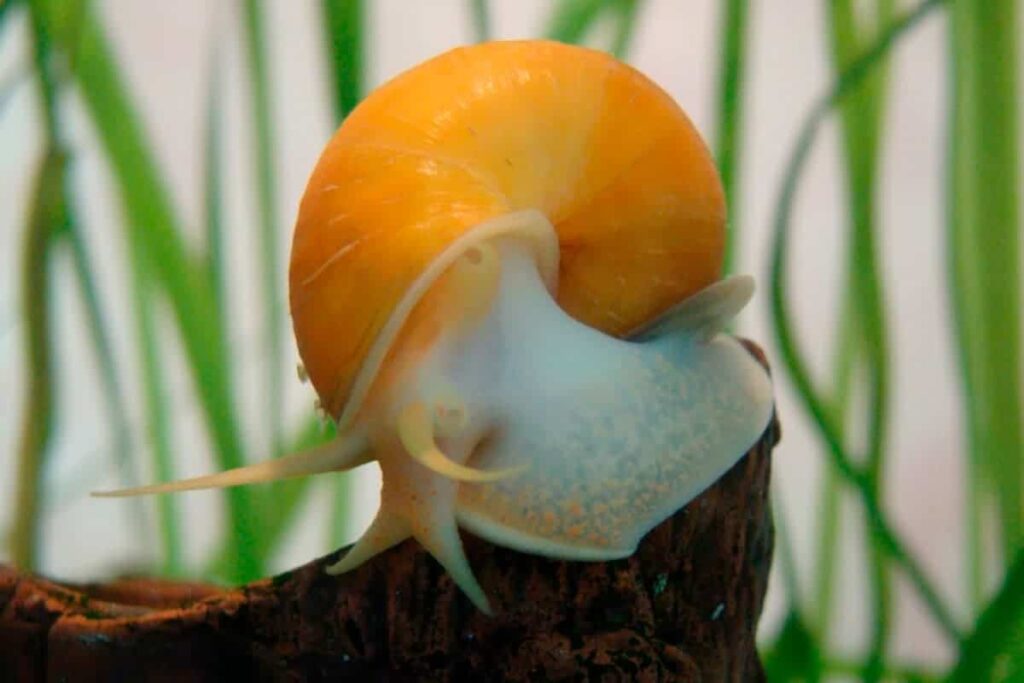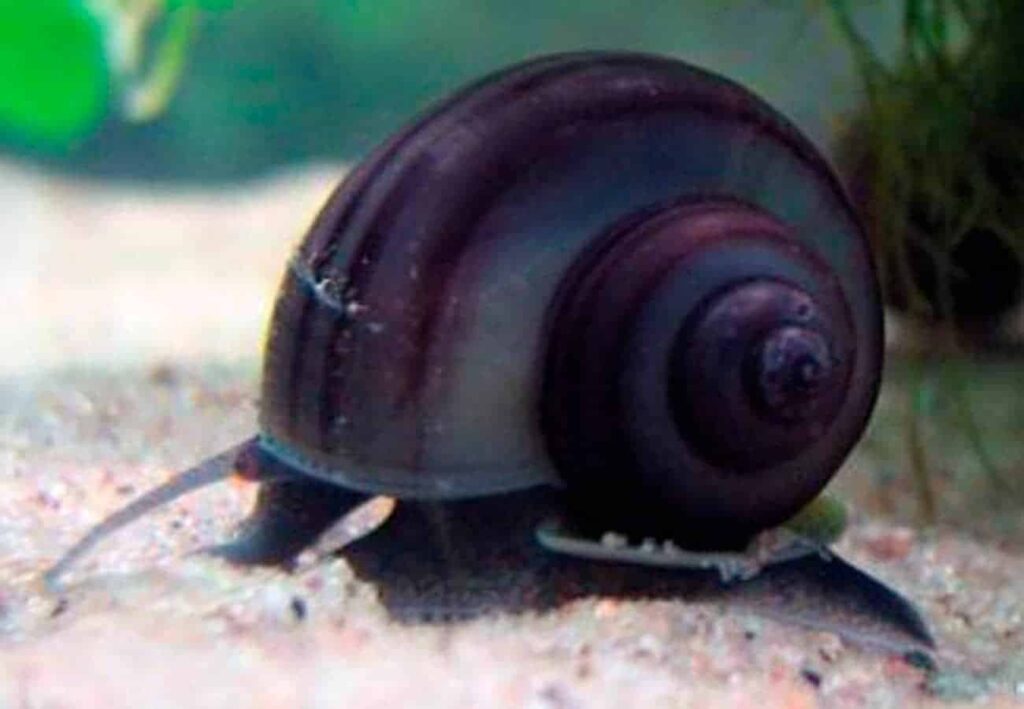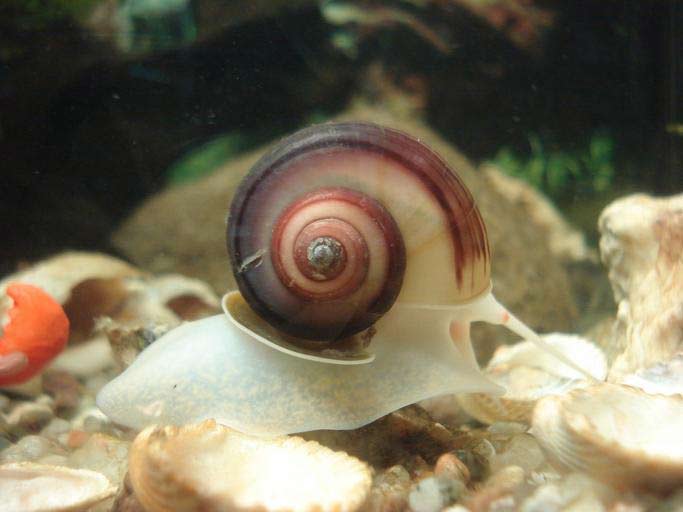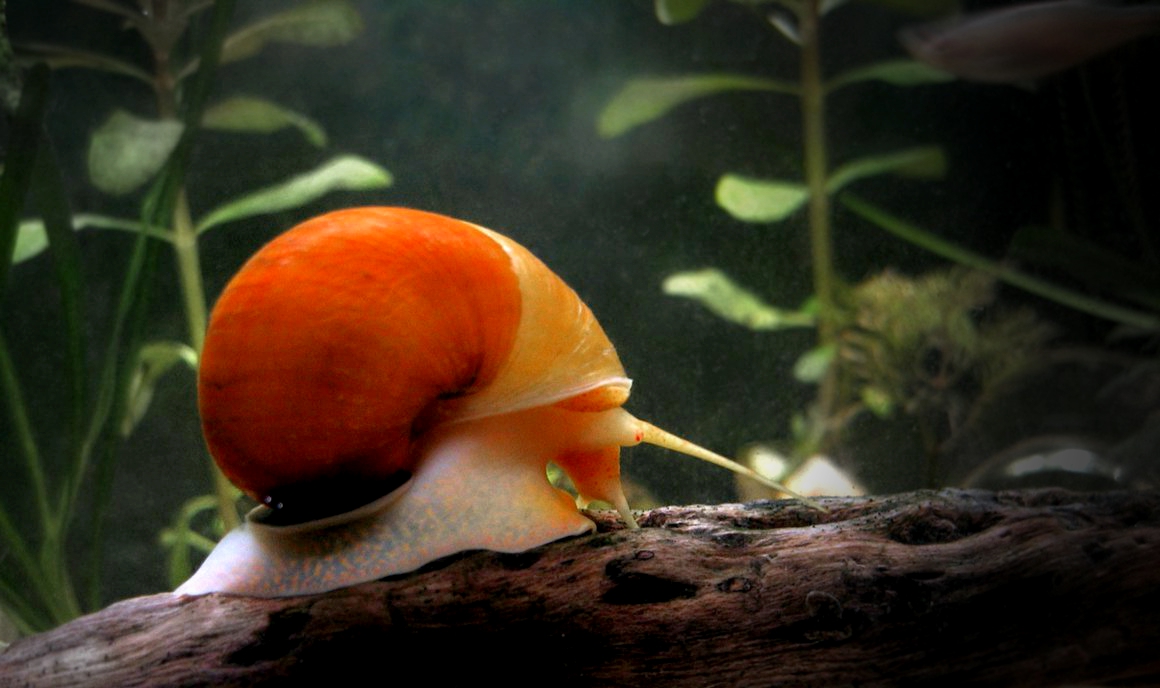Aquarists (aquarium hobbyists) add a variety of living and nonliving things to their aquariums. While some of these improve how the aquarium looks aesthetically, others serve a broader purpose. Some of these aquarium plants and beings can help you streamline or improve the growth of fish—or aquatic plants—you have inside the tank. We must also warn you about the plenty of options in the market, and aquarium snails are a great choice.
A freshwater aquarium snail is a particular type of snail fit for indoor freshwater tanks. Aquarium snails have been in the community of fish tank enthusiasts for a while, but they are not mainstream yet. As a result, people have quite a few doubts about them. We know this because we had the same doubts before we got a lovely aquarium snail for the tank.
In this comprehensive guide, we have covered everything you want to know about these invertebrates, the freshwater aquarium snails. Keep in mind, though, that we don’t focus on brackish (saltwater) water aquarium life here.
Here it goes.
Contents
Aquarium Snails: Pet or Pest?

Here is a fundamental question that almost every aquarium owner has: Is an aquarium snail a good or bad addition to the aquarium? Should they be considered pets, or are they a pest you need to remove? We can relate to the confusion, but something else can clear your queries.
Here is the idea you need to understand completely: aquarium snails are different from the regular or pond snails you may find outside. The former is called aquarium snails because they are proven to be safe for your aquarium. More importantly, these snails have become a valuable addition to the plants and beings in an aquarium. Therefore, you do not have to consider aquarium ones as pest snails.
If you think about it, you will not introduce a problem into the fish tank, would you? Therefore, considering that aquarium snails do not appear by themselves and that the owner has to add them to the tank, aquarium pets are still pets. We will be talking about safe-for-aquarium snails during the upcoming parts of the article.
Now, we understand that aquarium snails are pets. But, as you know, not all pets can coexist. So, when we bring that idea to the context of an aquarium, we have another doubt in front of us.
Can Snails and Fish Coexist?
As you know, fish and snails are some of the oldest species of beings you can find in the world. Both consider water bodies as their living space as well. For instance, if you check a pond, you will not have trouble finding snails and fish inside it. But whether snails and fish can coexist in an aquarium is a different question.
It should not surprise that not all snails and fish can coexist. Some snails will try to eat some fish and vice versa; pufferfish will pig out on snails, so be careful. However, this situation applies to only some of the snail-fish combinations out there. It means you would not have trouble with a variety of aquarium snails that do not affect the lives of the fish you have in the tank. Despite being in the same tank, these snails or fishes will not eat each other in your water community tank and will be very good tank mates. At the same time, as snails are good scavengers, you can have other advantages such as waste removal and increased quality of nutrients.
For instance, we can take the case of Apple Snails, one of the most popular species out there. It is effortless to take care of these snails, and their diet includes fresh vegetation underwater, decaying plants, and other algae in the planted tank (they are particularly attracted to algae wafers, for example, for obvious reasons). Therefore, you do not have to worry about the snails eating your live fish. This species can even work with betta and goldfish variants, which are slightly aggressive. In general, it would not take you a lot of time to find a combination of snails and fish that works.
Managing the Population of Aquarium Snails
Freshwater aquarium snails have a reputation for multiplying quickly, sometimes to the point of overwhelming an aquatic habitat. However, with a balanced approach, you can keep their numbers in check.
One effective strategy is to minimize overfeeding of fish, as excess food and waste create an abundant food supply for snails.
The inclusion of bottom-feeding fish such as loaches or catfish can further reduce food availability for snails, thereby controlling their population.
Regular tank maintenance and gravel vacuuming are also key factors in ensuring that snails don’t overrun the space. When managed properly, snails can offer several benefits without becoming a nuisance.
Creative Uses for Aquarium Snails
While the primary role of snails in many setups is utilitarian, particularly in their capacity as snails to clean fish tanks, they also bring a unique visual appeal to aquatic landscapes. Species like blue ramshorn and rabbit snails can accentuate specific design elements, such as a substrate of blue gravel.
Their vibrant, spiral shells serve almost like living ornaments, adding a dynamic layer to the tank’s visual palette. When paired with shrimp, these snails contribute to a multi-layered, mobile landscape, as long as the snails chosen are not predatory towards their crustacean tankmates.
The Pros and Cons of Keeping Fish Tank Snail Species
The decision to include aquarium snails in a freshwater setup is often a matter of personal preference and intended tank function. Peaceful algae-eating species such as nerites or rabbit snails are often good starting points. By managing their food sources and being vigilant about tank maintenance, you can enjoy the benefits of snails without the drawbacks of overpopulation.
Proper management allows for algae control and added aesthetic value, making the snails a worthwhile consideration for many tank setups.
Reasons to Keep Snails in Your Aquarium

You might be wondering, though. Why do you want to add snails to an aquarium in the first place?
Depending on what kind of an aquarium enthusiast you are, you could have several reasons why you need to keep a snail inside. However, we have tried to list some of the most common causes. As you can guess, most of these deal with how aquarium snails can benefit the fish/plant in the tank.
1. Aquarium snails are great pets
Aquarium snails are great pets, in case you didn’t know. You can grow these snails like growing other pets in a fish tank. Of course, taking care of a pet snail is not similar to taking care of a pet fish. While that learning curve remains valid, you can provide good care to your pet snail with some preparations.
Therefore, the first and foremost reason to keep a snail in your aquarium is that you would have to have it and nurture it as a pet. Depending on your preferences, you might even keep fish away from the aquarium. We say this because many build a snail-only aquarium with many algae and other vegetation.
2. They clean your aquarium debris & waste
Most types of aquarium snails you can find in the market belong to detritivores. You do not have to be warned by the name. It means most snails will survive in the aquarium by consuming decaying matter and calcium deposits. They have a function similar to loaches, for example. One good example would be Melanoides (i.e. Malaysian Trumpet Snail).
Decaying matter in an aquarium could be many things if you ask us. It could be the waste from fish, food that other aquarium components have not eaten, the wide variety of vegetation, and algae in the tank. As you can see, a few snails in the aquarium mean that you can deal less with waste.
Because aquarium snails and detritivores, you have an additional advantage. Even if you are ready to take care of all the waste from the tank at a time, the process can be tiresome to a great extent. You cannot ensure the smooth passage of air and other nutrients within the space even then.
Given the minimal size of aquarium snails, these animals would not have trouble reaching the tiniest parts in the aquarium. Therefore, you can stay confident that not a bit of food you put inside the tank goes to waste. Snails take resource utilization to a brand-new level if you ask us.
3. They play nice and are symbiotic with plant life
Provided that you have chosen a harmless aquarium snail, you do not have to worry about how they will affect the plants. These snails are skilled in identifying the about-to-die leaves of a plant and eating them. Some of them are also algae eaters. Therefore, you do not have to be alarmed if you feel like the snails are attacking the plants. It is not an attack. Instead, it’s a way the natural ecosystem keeps itself updated. When we look at things from this perspective, having an aquarium snail can boost the ecological sustenance in the tank.
4. Beneficial ones keep maleficent ones away
Here is another scenario, though. If you bought the aquarium and plants from a store, you might find some assassin snails (Clea Helena) hidden in the space. As you can guess, some of these snails may harm the tank. You can launch another set of aquarium snails into the tank during these times. These will clean out the dirt from the tank and take care of the problematic snails, which seem to be small most of the time. Thus you can keep snails in a tank to remove and keep other snails away, even for a temporary purpose.
We believe these reasons are convincing enough to make you keep an aquarium snail in the tank.
But it does not mean you can buy a random snail from the market and add it to the tank. Instead, we have to do some level of research before introducing (any) snail to the tank.
5. Snails as Living Art in Aquatic Setups
The spiraled shells and waving tentacles of snails create an underwater spectacle, adding depth and intrigue to their surroundings. When selected for their bright and patterned shells, species like nerites or rabbit snails elevate from being mere algae-eaters to becoming decorative highlights within the aquarium.
6. Aquarium Snails as Educational Tools
Observing the unique behaviors and biological processes of snails can be a fascinating educational experience, especially for children. From watching them mate and lay eggs to seeing them rasp algae from surfaces, snails offer a variety of interesting activities to witness.
Their manageable size and relatively simple care requirements make them ideal introductory pets for young hobbyists. The educational aspect of keeping snails, along with their functional and aesthetic benefits, adds yet another layer to the question: “Are snails good for freshwater aquariums?” Given the right conditions and care, the answer can be a resounding yes.
Aquarium Snail Types
We will first look at the two significant types of aquarium snails. It would help if you kept in mind that the two categories shown below are relative.
Beneficial Aquarium Snails

As the name says, beneficial aquarium snails will contribute to the well-being of the aquarium and the fish or plants you have inside. Most types of aquatic snails you find will belong to this category. As we mentioned in the previous section, these snails will survive by consuming dead plant matter, decaying fish, and algae in the tank. Because they can reach out to the smallest parts of the aquarium, these snails effectively increase the air circulation within the aquarium.
You can consider getting one of these snails if you need a natural way to boost the results from an aquarium. You can find a few options in this category, such as:
- Malaysian Trumpet Snail is one of the most popular species in this category. They have a cone-shaped body and are good at removing dirt from even the most disgusting parts of the aquarium. Since MTS females can reproduce without the help of males, you can have a good number of snails in a short period. Even though you may have to deal with the numbers at a later date, the snails can keep your aquarium aerated for the most part. They are also popular among aquarium owners because these snails do not eat plants.
- Apple Snails (Pomacea bridgesii, also known as Mystery Snails) are also very common in aquariums across the world. Compared to the first one, Apple Snails look incredibly beautiful. It is one reason why many people consider Apple Snails as standalone pets. You can tell these snails apart from the other species by looking at their globe-like shell and long tentacles. Both these designs allow the snails to move around in the water and collect decaying matter, especially around siphons. It is also impressive that an Apple Snail can have a lifespan of up to 5 years, an excellent element for long-term aquarium maintenance.
- Nerite Snails can also be added to the list of beneficial snails without a doubt. A common species you’ll encounter is Zebra nerite snails (Neritina natalensis Zebra). You can find some level of color-based varieties within this species. So, if you want to add an aquarium snail that looks good and adds something to the ambiance, Nerite snails can be the way to go. Because these snails do not reproduce in freshwater, you do not have to worry about increasing numbers on any day. At the same time, maintaining them is very easy. You can add a few extra drops of fish pellet or other fish food if you cannot find many algae in the water.
As you can guess, there are so many varieties in the market. Devil Spike Snails, which eat decaying fish and shrimps, Rabbit Snails which get along with all aquarium life and are very explorative, Chinese Mystery Snails (i.e. Trapdoor Snails), and Ramshorn Snails, which consume fresh vegetation and decaying plants, are definitely on that list.
Harmful Snails
As we said, the harmful snail is a relative concept. The snails themselves are not harmful to the fish or plants in the water. However, what these snails do underwater could be problematic. These damaging snails will be messing with the aquatic plants you have added to the aquarium. There are even cases when some snail species may attack the fish you have in the tank (for example, your catfish or cichlids).
There are also some problems with how the number of snails can impact the biological sustenance of the tank. There could be situations when the existing plants or fish cannot cope with the increasing harmful snail population.
We cannot give you a list of harmful snails, however, because some varieties of so-called good snails can also cause some problems.
For instance, aquarium enthusiasts worldwide have noticed that some types of Apple Snail become a nuisance in that they eat a lot of aquatic plants. Even though they stick to the plants, things could be problematic if you have built a lushing and green environment for your fish. Similarly, some species (e.g. Bladder Snails) have also raised problems by killing other types of animals you may introduce to the tank. For instance, we have seen a noticeable impact of shrimp, which are eaten before they are dead and decayed. Gold Inca Snails are very hungry, so when they run out of food they will nibble on your plants.
The solution here is to get aquarium snails from trusted places. If you source them from an affordable yet low-quality space, you will have problems in the future.
What Do Snails Eat?
Aquarium snails eat the following things, depending on the situation
- Live plants, including stems, crops, fruits, bark, driftwood, and leaves
- Fungi, mushrooms, algae, and other freshwater plants
- Decayed plant matter, uneaten food, and dead organic matter
- Debris, detritus, and retained elements in the soil
- Small animals like earthworms, if they are present in the aquarium
- Other small fish and shrimps depending on the species
- Fish pellet or other food provided for fish
As you can see, the standard diet of a snail is pretty comprehensive. Depending on the situation, they can be seen consuming various elements. For instance, we can consider the case of the Apple Snail. Some Apple Snail varieties were found to consume small plants and animals in some parts of the world. However, for the most part, the snails you get for aquarium purposes live by eating the debris and other decayed stuff from the bottom of the tank.
These are some of the reasons you should understand the type of snail before you get one.
Potential Problems with Aquarium Snails

You do not see the potential problems with aquarium snails too soon in most cases. These beings may take a few months or years to impact the tank. Some of the common issues are:
- If you are not careful about choosing the right aquarium snails, the snails may consume fish, shrimp, and other beings in the tank. In the same way, aquarium snails can also start munching on the aquatic plants you have in the system.
- Overpopulation is also a problem with some types of aquarium snails. As we said, some species of snails can be pretty aggressive when it comes to mating, reproduction, and laying snail eggs everywhere (e.g. Mystery Snails). In those cases, it will not take more than a few weeks or months to fill your tank with too many of them, which is not great.
- If some snails manage to get into the aquarium by accident, removing them could be a pain in the ass. You may even have to launch another set of snails to eradicate the problematic group. By the time you see some success, the complex group may have exhausted the resources in the tank.
- Last but not least, the biological activities of some aquarium snails may mess with how some plants and fish live underwater. As you may know, some fish and plants require the water to have a specific pH value, among other things, and don’t accept water changes, or changes in water quality too kindly. Too many snails in the tank can make this a tough dream to achieve.
As you can see, the problems with aquarium snails have to do with how you take care of them. If you keep maximum control over which aquarium snails become part of the tank, you can control the problems to an extent.
Conclusion
We have included everything you need to know about aquarium snails in the article. Ensure that you go through each section before choosing a species of snail to enhance your aquarium hobby. We also suggest you browse through offerings on websites such as Amazon, eBay, and the like.
As much as a suitable species can make your aquarium a more aerated and cleaner place, destructive species can cause irrecoverable damage, which is not so amazing!

Ian Sterling, founder of Fishlab.com, began his aquarium journey over 30 years ago, driven by a deep fascination for fish and their diverse personalities. His website, Fishlab.com, is dedicated to making fishkeeping accessible and enjoyable, offering beginner-friendly guidance, expert insights, and a community for aquarists to connect and share experiences.


